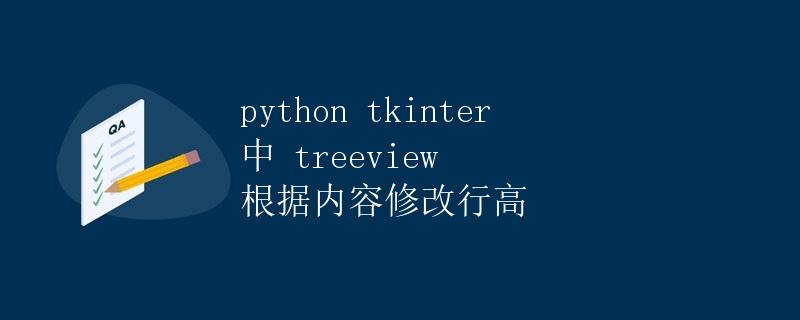Python tkinter 中 treeview 根据内容修改行高

在使用 Python 中的 tkinter 模块进行 GUI 编程时,经常会用到 Treeview 控件来展示表格数据。在默认情况下,Treeview 控件中的每一行高度是固定的。然而,有时我们希望根据每一行内容的不同来动态调整行高,以适应内容的显示。本文将介绍如何通过 tkinter 中的 Treeview 控件来实现根据内容修改行高的功能。
1. 安装 tkinter
首先,我们需要安装 tkinter 模块。如果你使用的是 Python 3,那么 tkinter 应该是自带的,无需额外安装。如果需要安装,请执行以下命令:
pip install python-tk
2. 创建带有 Treeview 控件的窗口
首先,我们创建一个简单的窗口,并在窗口中添加一个 Treeview 控件,用来展示数据:
import tkinter as tk
from tkinter import ttk
root = tk.Tk()
root.title("Dynamic Row Height in Treeview")
tree = ttk.Treeview(root, columns=("col1", "col2"), show="headings")
tree.heading("col1", text="Column 1")
tree.heading("col2", text="Column 2")
tree.pack()
root.mainloop()
运行以上代码,会弹出一个空窗口,并在窗口中显示一个包含两列的 Treeview 控件。
3. 初始化数据和内容
接下来,我们初始化一些数据和内容,用于向 Treeview 控件中添加行数据。这里我们简单地使用一个列表来模拟数据:
# Mock data
data = [
{"col1": "Row 1", "col2": "This is a very long text that will occupy multiple lines in this cell."},
{"col1": "Row 2", "col2": "Another long text for the second row in the second column."},
]
# Insert data into Treeview
for item in data:
tree.insert("", "end", values=(item["col1"], item["col2"]))
以上代码将两行数据插入到 Treeview 控件中,每行分别包含两列文本数据。运行代码后,窗口中将展示这两行数据。
4. 根据内容调整行高
现在,我们来实现根据每行内容的不同来动态调整行高的功能。我们可以通过以下代码来实现这一功能:
def adjust_row_height(event):
for row_id in tree.get_children():
cell_height = max(tree.bbox(row_id, column)[3] - tree.bbox(row_id, column)[1] for column in tree["columns"])
tree.rowheight(row_id, cell_height)
tree.bind("<Configure>", adjust_row_height)
以上代码中的 adjust_row_height 函数会在窗口大小调整或者内容更新时被调用,它会遍历当前 Treeview 控件中的所有行,并根据每行内容的高度来调整行高,以确保内容完全显示。运行代码后,可以看到每行的行高会根据内容动态调整。
5. 完整代码
下面是以上所有代码的完整版本:
import tkinter as tk
from tkinter import ttk
# Create window
root = tk.Tk()
root.title("Dynamic Row Height in Treeview")
# Create Treeview
tree = ttk.Treeview(root, columns=("col1", "col2"), show="headings")
tree.heading("col1", text="Column 1")
tree.heading("col2", text="Column 2")
tree.pack()
# Mock data
data = [
{"col1": "Row 1", "col2": "This is a very long text that will occupy multiple lines in this cell."},
{"col1": "Row 2", "col2": "Another long text for the second row in the second column."},
]
# Insert data into Treeview
for item in data:
tree.insert("", "end", values=(item["col1"], item["col2"]))
# Adjust row height based on content
def adjust_row_height(event):
for row_id in tree.get_children():
cell_height = max(tree.bbox(row_id, column)[3] - tree.bbox(row_id, column)[1] for column in tree["columns"])
tree.rowheight(row_id, cell_height)
tree.bind("<Configure>", adjust_row_height)
root.mainloop()
6. 结论
通过以上代码,我们成功实现了在 tkinter 的 Treeview 控件中根据内容调整行高的功能。这一功能可以使得表格数据更加美观,适应不同内容长度的显示需求。
 极客教程
极客教程